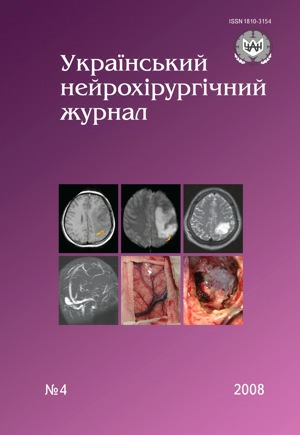Diagnostics peculiarity of recurrent intervertebral lumbar disc herniation
DOI:
https://doi.org/10.25305/unj.108388Keywords:
поперековий відділ хребта, грижа міжхребцевого диска, рецидив, методи діагностики.Abstract
Many methods are used to evaluate the state of lumbar spine after surgery. The current neuroimaging tool of choice is Gd-enhanced MR-imaging for postdisceсtomy recurrent symptoms investigation. To recognize postoperative pathological changes the doctor must be familiar with changes appropriate for early and late phases of postoperative period.References
Airaksinen O., Herno A., Turunen V. et al: Surgical outcome of 438 patients treated surgically for lumbar spinal stenosis // Spine. — 1997. — V.22. — P.2278–2282.
Babar S., Saifuddin A. MRI of the post-discectomy lumbar spine // Clin. Radiol. — 2002. — V.57. — P.969–981.
Barrera M.C., Alustiza J.M., Gervas C. et al. Post-operative lumbar spine: comparative study of TSE T2 and turbo-FLAIR sequences vs contrast-enhanced SE T1 // Clin. Radiol. — 2001. — V.56. — P.133–137.
Bernard T.N. Jr. Using computed tomography/discography and enhanced magnetic resonance imaging to distinguish between scar tissue and recurrent lumbar disc herniation // Spine. — 1994. — V.19. — P.2826–2832.
Bernsmann K., Kramer J., Ziozios I. et al. Lumbar micro disc surgery with and without autologous fat graft. A prospective randomized trial evaluated with reference to clinical and social factors // Arch. Orthop. Trauma Surg. — 2001. — V.121. — P.476–480.
Boden S.D., Davis D.O., Dina T.S. et al. Contrast-enhanced MR imaging performed after successful lumbar disk surgery: prospective study // Radiology. — 1992. — V.182. — P.59–64.
Carragee E.J., Han M.Y., Suen P.W. et al. Clinical outcomes after lumbar discectomy for sciatica:The effects of fragment type and anular competence // J. Bone Joint Surg. Am. — 2003. — V.85. — P.102–108.
Cinotti G., Roysam G.S., Eisenstein S.M. et al. Ipsilateral recurrent lumbar disc herniation. A prospective, controlled study // J. Bone Joint Surg. Br. — 1998. — V.80. — P.825–832.
Deutsch A.L., Howard M., Dawson E.G. et al. Lumbar spine following successful surgical discectomy. Magnetic resonance imaging features and implications // Spine. — 1993. — V.18. — P.1054–1060.
Erbayraktar S., Acar F., Tekinsoy B. et al. Outcome analysis of reoperations after lumbar discectomies: a report of 22 patients // Kobe J. Med. Sci. — 2002. — V.48. —P.33–41.
Georgy B.A., Hesselink J.R., Middleton M.S. Fat-suppression contrast-enhanced MRI in the failed back surgery syndrome: A prospective study // Neuroradiology. — 1995. — V.37. —P.51–57.
Glickstein M.F., Sussman S.K. Time-dependent scar enhancement in magnetic resonance imaging of the postoperative lumbar spine // Skelet. Radiol. — 1991. — V.20. — P.333–337.
Grane P., Tullberg T., Rydberg J. et al. Postoperative lumbar MR imaging with contrast enhancement. Comparison between symptomatic and asymptomatic patients // Acta Radiol. — 1996. — V.37. — P.366–372.
Graver V., Haaland A.K., Magnaes B. et al. Seven-year clinical follow-up after lumbar disc surgery: results and predictors of outcome // Br. J. Neurosurg. — 1999. — V.13. — P.178–184.
Haughton V., Schreibman K., De Smet A. Contrast between scar and recurrent herniated disk on contrast-enhanced MR images // Am. J. Neuroradiol. — 2002. — V.23. — P.1652–1656.
Kardaun J.W., While L.R., Shaffer W.O. Acute complications in patients with surgical treatment of lumbar herniated disc // J. Spin. Disord. — 1990. — V.3. — P.30–38.
Mobbs R.J., Newcombe R.L., Chandran K.N. Lumbar discectomy and the diabetic patient: incidence and outcome // J. Clin. Neurosci. — 2001. — V.8. — P.10–13.
Robinson D., Mirovsky Y., Halperin N. et al. Changes in proteoglycans of intervertebral disc in diabetic patients. A possible cause of increased back pain // Spine. — 1998. — V.23. — P.849–856.
Ross J.S. Magnetic resonance imaging of the postoperative spine // Seminars Musculoskelet. Radiol. — 2000. — V.4. — P.281–291.
Ross J.S. MR imaging of the postoperative lumbar spine // Magn. Reson. Imag. Clin. N. Am. — 1999. — V.7. — P.513–524.
Sarrazin J.L. Imaging of postoperative lumbar spine // J. Radiol. — 2003. — V.84. — P.241–250.
Simpson J.M., Silveri C.P., Balderston R.A. et al. The results of operations on the lumbar spine in patients who have diabetes mellitus // J. Bone Joint Surg. Am. — 1993. — V.75. — P.1823–1829.
Slotman G.J., Stein S.C. Laminectomy compared with laparoscopic discectomy and outpatient laparoscopic discectomy for herniated LV–SI intervertebral disks // J. Laparoendosc. Adv. Surg. Tech. — 1998. — V.8. — P.261–267.
Suk K.S., Lee H.M., Moon S.H. et al. Recurrent lumbar disc herniation: Results of operative management // Spine. — 2001. — V.26. — P.672–676.
Van de Kelft E.J., van Goethem J.W., de La Porte C. et al. Early postoperative gadolinium-DTPA-enhanced MR imaging after successful lumbar discectomy // Br. J. Neurosurg. — 1996. — V.10. — P.41–49.
Downloads
Published
How to Cite
Issue
Section
License
Copyright (c) 2008 I. N. Dikan, A. A. Eroshkin, A. V. Ryabikin

This work is licensed under a Creative Commons Attribution 4.0 International License.
Ukrainian Neurosurgical Journal abides by the CREATIVE COMMONS copyright rights and permissions for open access journals.
Authors, who are published in this Journal, agree to the following conditions:
1. The authors reserve the right to authorship of the work and pass the first publication right of this work to the Journal under the terms of Creative Commons Attribution License, which allows others to freely distribute the published research with the obligatory reference to the authors of the original work and the first publication of the work in this Journal.
2. The authors have the right to conclude separate supplement agreements that relate to non-exclusive work distribution in the form of which it has been published by the Journal (for example, to upload the work to the online storage of the Journal or publish it as part of a monograph), provided that the reference to the first publication of the work in this Journal is included.









